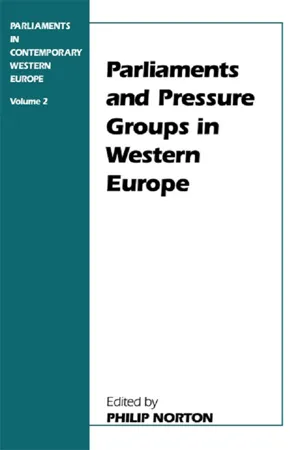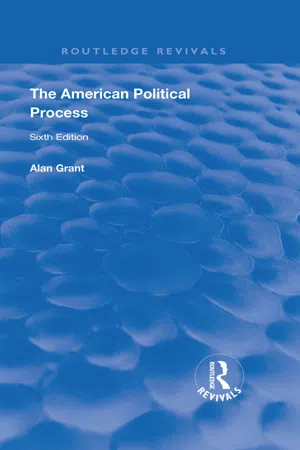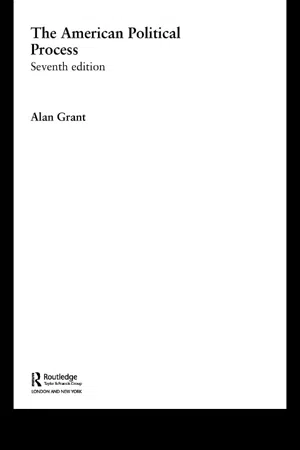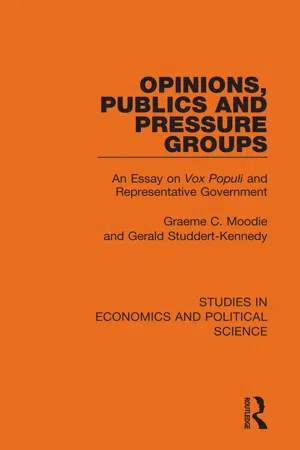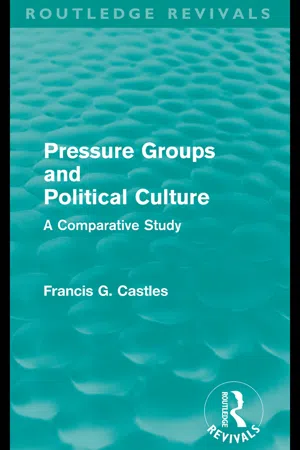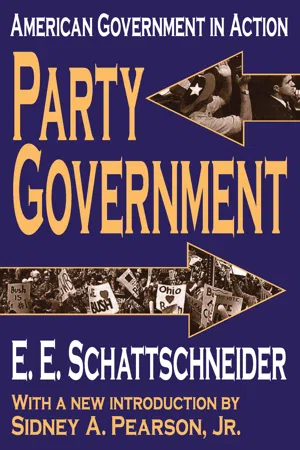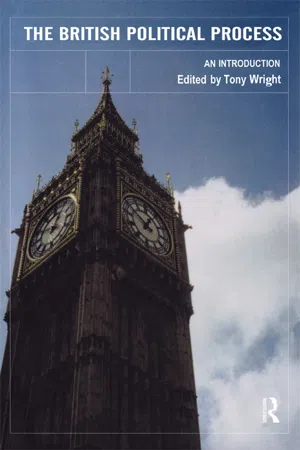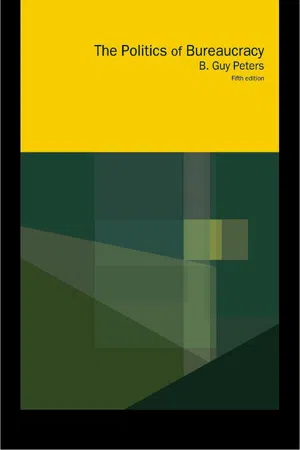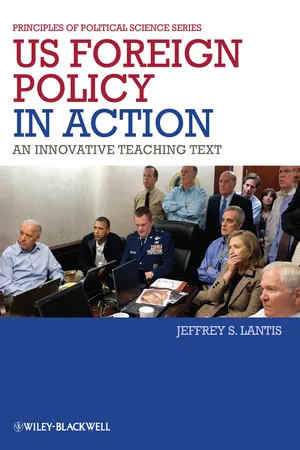Politics & International Relations
Pressure Groups
Pressure groups are organizations that seek to influence government policies and decisions on specific issues. They do not seek to directly control government, but rather to advocate for their interests and causes. Pressure groups can take various forms, such as trade unions, environmental groups, or professional associations, and they play a significant role in shaping public policy.
Written by Perlego with AI-assistance
Related key terms
9 Key excerpts on "Pressure Groups"
- Philip Norton, Philip Norton(Authors)
- 2012(Publication Date)
- Routledge(Publisher)
Some groups may even be formed for the purpose of achieving a change in public policy. In west European states, groups attempting to affect the outcome of public policy are numerous. Groups will make representations to policy makers – an activity known as lobbying, after the place (the lobby just outside the legislative chamber) where influence-peddlers used to operate – to try to get them to accept their desired ends. Nor is such activity confined to the national level. State and local government are targets for lobbying by groups. 2 So too are the institutions of the European Union. Group activity is thus an important part of the political environment of Western states. The institutions of the state are not politically autonomous. They exist in an increasingly crowded political environment, shaped and constrained by political parties and buffeted by demands for action from a myriad of organised groups. Yet just how much are group demands directed at the central elected assembly – the legislature? 3 What is the relationship between parliaments and those groups attempting to influence public policy? The relationship is not one that has been the focus of much literature, either on parliaments or on policy analysis. It is this relationship that forms the basis of this study. Are parliaments ignored by groups or are they a magnet for group demands, and – if they are the subject of group demands – does that activity have any discernible consequence for the groups and for the parliaments? And what are the consequences of the relationship between Pressure Groups and parliaments for the political system? Pressure Groups The classic definition of a pressure, or interest, group is that it is a body that seeks to influence government in the allocation of resources without itself seeking to assume responsibility for government. This distinguishes Pressure Groups from political parties- eBook - ePub
- Alan Grant(Author)
- 2019(Publication Date)
- Routledge(Publisher)
5 Pressure Group PoliticsWe have observed already that politics in the United States can be seen as a continuous process of different groups competing to persuade the formal institutions to reflect their interests and objectives in the official policies of the nation, state or locality.1 Having examined the working of the three branches of the federal government, it is now time to consider how these groups operate, what contribution they make to the political process, and how the political system provides checks on their power.Pressure Groups and political parties are often described as ‘informal’ political institutions, because although they are not mentioned in the Constitution as official bodies, an understanding of their role in the system is essential for a proper appreciation of policy making. Indeed, in our consideration of the formal institutions the importance of these bodies should already have been clear. Pressure Groups are organized attempts to influence government policy rather than institutions which try to control the government and enter candidates in elections for office. In this respect they are different from parties, which are examined in the next chapter. Pressure Groups should also be distinguished from the many social groups that exist to promote objectives that have no political content—sports clubs, operatic societies, rotary clubs, parent-teacher associations and private charities are formed by groups of people who have similar interests, but their common activities do not normally involve government or attempts to influence its policy. On the other hand, if there is the danger of a major highway being built across the sports club’s field, or if the government proposes to change the tax status of a charity, then even these groups may enter the political arena. - eBook - ePub
- Alan Grant(Author)
- 2003(Publication Date)
- Routledge(Publisher)
Public opinion can act as a constraint on the power of even the most deeply entrenched and influential Pressure Groups. Public suspicion means that groups’ claims are often regarded with scepticism and their motives and policies are constantly being examined and questioned. Pressure Groups may be able to delay action for a while, but if there is widespread public support for a particular policy, as evidenced by opinion polls and legislators’ constituency soundings, it may prove impossible to prevent legislation or the execution of a policy indefinitely. For example, the American Medical Association spent millions of dollars in their campaign against federal ‘socialized medicine’ but the strength of public support ensured the eventual passage of Medicare legislation in 1965.Chapter summary
- The American political system is particularly open to the influence of Pressure Groups. The diversity of American society, the size of the country and the complexity of its economy have all helped to create a vast array of different groups seeking to influence public policy. The political culture, the decentralised nature of the political system which allows many access points where groups can lobby and persuade, and the relative weakness of political parties have all enabled Pressure Groups to play an important role in the policy-making process. In states that allow referendums and initiatives as forms of direct democracy Pressure Groups can influence the voters who can make decisions on policy matters themselves.
- Pressure Groups fall into two main categories: interest groups whose goals are to protect, defend and promote the interests of their own members and promotional groups which are trying to secure political objectives which are in the interests of people other than themselves or to promote a cause which they believe is in the interests of society as a whole. Some organisations are also variously described as ‘citizens’ groups’, ‘public-interest groups’ and ‘single-issue groups’.
- There are a number of methods which Pressure Groups legitimately use to influence government and public policy. These are electioneering and contributing financially to candidates’ campaigns, lobbying, court litigation, grass-roots pressure by their members including participation in marches and demonstrations, publicity and advertising through the media and seeking to influence the policies of the political parties. A small minority of groups is willing to break the law and resort to violence and the promotion of civic disorder in order to achieve their goals.
- eBook - ePub
Opinions, Publics and Pressure Groups
An Essay on 'Vox Populi' and Representative Government
- Graeme C. Moodie, Gerald Studdert-Kennedy(Authors)
- 2021(Publication Date)
- Routledge(Publisher)
The Legislative Process in Great Britain (Allen & Unwin, 1968), Chs. Ill and IV.2 PEP, Advisory Committees in British Government (Allen & Unwin, 1960), pp. 112-13.3 See Samuel H. Beer, Modem British Politics (Faber, 1965), and especially the definitions of functional and territorial representations on pp. 71-3.Terminology
By ‘pressure group’ we mean, simply, any organized group which attempts to influence government decisions without seeking itself to exercise the formal powers of government.4 The latter part of the definition is usually intended to distinguish a pressure group from a political party or conspiratorial group, while the stress on organizations distinguishes it from a mob or other spontaneous collection of individuals. Again in line with established usage, we do not mean to imply, by labelling an organization as a pressure group, that its sole or even principle aim is to influence government; we mean no more than that it does, on occasion, pursue that aim.4 This is virtually identical with other widely accepted definitions. See, for example, H. Eckstein, Pressure Group Politics (Allen & Unwin, 1960), pp. 9-11. It is also almost identical with what S. E. Finer, op. cit., pp. 2-5, means by a ‘lobby’.Disputes about terminology are as often fruitless as not, but in this case it is necessary to say why we reject another prevalent label, that of ‘interest group’.1 The trouble with this label as we see it lies in the risk of confusion with other established usages. On the one hand ‘interest groups’ are frequently contrasted with ‘attitude’, ‘promotional’ or ‘cause’ groups, as a means of classification within the general population of Pressure Groups. Even as such the term is open to objection, but it has an established reference to those Pressure Groups whose members are linked by a shared interest of, normally, an economic or occupational kind; it is best retained exclusively for this use.2 On the other hand, the term is liable to confusion with the notion simply of an interest, in the sense in which that word was used in, for example, the Philadelphia Convention of the American Founding Fathers, or the nineteenth-century debates on suffrage extension in both die usa and Britain. We feel that it is still usefill to be able to talk of the commercial, landed, church, business, or labour interest, in the sense of an identifiable and important section of the community whose responses and welfare no government dare ignore, without any necessary implication that it is organized or has a single spokesman or pressure group to represent it. Indeed, it is important to distinguish an interest (in this admittedly slightly old-fashioned sense) from the variety of Pressure Groups which may be formed from its members—there are, for example, too many conflicting perceptions and priorities within the broad interests of business and labour for it to be sensible to refer to either as a pressure group—if only because, as we will argue below, an important feature of the pressure-group system - eBook - ePub
Pressure Groups and Political Culture (Routledge Revivals)
A Comparative Study
- Francis Castles(Author)
- 2009(Publication Date)
- Routledge(Publisher)
Eckstein further notes that groups tend to articulate themselves on the pattern of the governmental institutions with which they have dealings. That is to say, they develop a similar hierarchy, and in the case of the B.M.A. he illustrates the close ties between the associational hierarchy and the civil service. Other issues which have received some theoretical attention have been the existence of what John Kenneth Galbraith calls ‘counter-vailing’ pressures (J.K.Galbraith, 1958), i.e. where the existence of one interest or attitude group is to some extent cancelled out by one with a contrary purpose—for instance, anti-blood sports groups are to some extent neutralized by the Field Sports Society, which has on occasion been able to mobilize up to 100,000 members (Allen Potter, 1961). The phenomenon of ‘over-lapping’ membership is another which has been discussed, because it provides a curb against the unbridled use of pressure group power. The fact that one is a member of both the R.S.P.C.A. and the Field Sports Society means one is only against fox hunting ‘in principle’. One last, much discussed aspect of interest group activity is the ‘potential group’, that is to say, a group which comes into existence when there is a threat to its implicitly held values. In effect, of course, every group was once a potential group until some sort of threat was felt. An example here might be the gradual growth of the Noise Abatement Societies in the face of ever-increasing jet air transport.The problems
Thus while it is possible to point to a certain amount of research in the field we may also note certain deficiencies. Most specifically, the state of research on pressure group politics presents two basic problems if we are ever to attain some general categorization in theoretical terms of group politics as it operates in differing political systems. These may be delineated as follows:- (i) The emphasis on interest groups has led to not altogether acceptable generalization of the categories used in their study to Pressure Groups as a whole. As an example of this we may take Finer’s definition of the Lobby, that is to say, the sum of groups operating within the Polity: ‘The sum of organizations insofar as they are occupied at any point in time in trying to influence the policy of public bodies, though unlike political parties, never themselves prepared to undertake the direct government of the country’ (Finer, 1958, p. 2) (my italics). What must be noted here is that while such a definition may be entirely fitting for an interest group, it is by no means so obviously applicable to an attitude group, such as the Campaign for Nuclear Disarmament. The history of this movement would seem to indicate that, even if it was not as such an ‘organization willing to take over direct government of the country’, certain integral groups contemplated action whose logical consequences must have in-eluded such an act. In this context we may note various proposals for putting up ‘unilateralist’ candidates, ‘Voter’s Veto’ (a campaign designed to see that voters did not vote for any multilateralist candidate), not to mention the activities of the Committee of One Hundred. (See later chapter 7
- eBook - ePub
Party Government
American Government in Action
- E. Schattschneider(Author)
- 2017(Publication Date)
- Routledge(Publisher)
Parties and Pressure Groups differ as to method, therefore, and the method used in turn dominates the objectives of these types of political organization. In its nature the method of controlling government by nominating candidates who contest elections involves total control of the government, though it may not be perfectly successful. If a party wins an election it wins general control of the policies and activities of the government. The parties play for the supreme stakes of power. On the other hand, Pressure Groups are not organized to take over a government in its entirety; they seek to accomplish specific, relatively narrow tasks, to influence policy at selected points, and do not aim at winning the general power to govern. Compared with the responsibilities assumed by the parties, the function of Pressure Groups is extremely restricted. A pressure group may content itself with bringing about a single result, the passage of one bill, the defeat of one tax increase, the reversal of a particular executive ruling, the construction of a special bridge, or the adoption of a particular tariff rate on a special commodity, though some Pressure Groups sponsor policies more broadly conceived than those promoted by others. If the party is a corporation which takes possession of the ship by virtue of a mandate from the owners, the pressure group is little more than a stowaway smuggled aboard with the cargo.Pressure Tactics
Before proceeding with the discussion of the implications of the fact that parties fight election campaigns and Pressure Groups avoid them, it is necessary to examine more closely the method of pressure politics. How is it possible to influence public policy without winning elections? The method of pressure politics, like all other political methods, must meet one fundamental requirement if it is to be adopted widely. It must work easily.How can organized minorities or groups, unable to win elections or unwilling to make the effort to do so, induce the government to adopt the policies they advocate? Obviously a pressure group might influence policy by creating a general opinion - eBook - ePub
The British Political Process
An Introduction
- Tony Wright(Author)
- 2002(Publication Date)
- Routledge(Publisher)
Different methods are used by groups to pursue their objectives. Insider groups are more likely to use influence in Whitehall and Westminster and resort to external protest only when their voice is not being heard. Outsider groups and cause groups are more likely to be dependent on the media and the public to sustain their authority and spread their message as well as to raise their funds. Pressure Groups commonly produce material in the form of leaflets and pamphlets and mobilise support in the form of strikes, demonstrations and mass lobbies, all with varying degrees of success. When insider interests combine with popular pressure (as with the successful campaign by the financial services industry in 1998 to change government proposals on tax-exempt savings schemes), the political impact can be particularly effective.Groups rise or fall as issues change and public concerns move on. The Campaign for Nuclear Disarmament (CND) has seen a sharp decline in support in recent years, for example, while environmental and animal welfare groups have grown in size and significance. The pressure group world is a dynamic one. The relationship between organised groups and the political parties is particularly interesting. The parties like to win group support, although picking fights with unpopular groups (as Mrs Thatcher did with the trade unions) can sometimes be useful. Groups are usually wary of seeming too close to political parties, although there are times when one group may decide that converting a party to its cause is the best way to achieve its objectives. The animal welfare movement in recent years has deliberately associated itself with the Labour Party for this reason, and Labour was glad to have this support. When the Labour government did not immediately move to ban fox-hunting (partly under pressure among a rival ‘countryside’ movement that had begun to exercise itself energetically), this provoked considerable disappointment among the anti-hunting Pressure Groups (Figure 5.1 ).There have been close links in the past between the Conservative Party and business interests and between the Labour Party and trade unions. However, these historic attachments have been called into question by the deliberately ‘inclusive’ ambitions of Tony Blair’s New Labour, with its wooing of business and message to the trade unions that ‘fairness not favours’ was now the nature of the relationship. Many commentators consider that New Labour is more likely to listen to the Confederation of British Industry (CBI) than the unions. - eBook - ePub
- B. Guy Peters, Guy Peters(Authors)
- 2002(Publication Date)
- Routledge(Publisher)
64 It is especially pronounced when leadership roles involve regular participation in important negotiations over policy, and frequent contacts with government officials. There is a danger that interest groups become too much a part of the system of government to represent adequately the wishes of their members to government.Institutional groups. Institutional Pressure Groups appear to constitute a special class of legitimate Pressure Groups. By definition, these groups are important social or political institutions that are seeking to influence public policy.65 Some rather obvious examples are the church, the army, and the public bureaucracy itself. Local governments, even in unitary regimes, may also act as institutional groups. Institutional groups, like all interest groups, seek to obtain benefits for themselves or their members, and their actions are legitimated through the prestige of the institution, or perhaps the threat of extreme actions in the case of the army in some societies. Johansen and Kristensen point out that these groups are increasing more rapidly than functional interest groups in their representation on public committees in Denmark.66 Likewise, in France, Tournon argues that these are the most effective groups in the system.67Even in countries that tend toward legitimate patterns of interaction between interest groups and the bureaucracy, institutional interest groups may actually be better conceptualized as a special class of clientela groups in that they have legitimate access when a number of competing groups may not, and they tend to seek more particularized special-interest outputs than tends to be true in legitimate pressure group systems. This is often particularly true of local government organizations that lobby for support from the central government, whether as a group or for their own particular community.68 - eBook - ePub
US Foreign Policy in Action
An Innovative Teaching Text
- Jeffrey S. Lantis(Author)
- 2012(Publication Date)
- Wiley-Blackwell(Publisher)
Interest groups, or lobbies, are organizations that seek to influence government policy outcomes to their own, cartelized special concerns. Interest groups may represent a wide range of constituencies, from farmers and families to immigrant groups and corporations, while actual lobbies are specialized in their representation of interests. For example, lobbies may represent for-profit companies, like military contractors or automobile manufacturers, or non-profit concerns like protection of human rights or the environment. The most effective foreign policy interest groups are typically well organized, managed by a national organization with staff and resources, and have a broad membership. However, scholars disagree whether interest group engagement in the policy process is constructive. Some champion democratic ideals and the “power of the people” to shape political decisions; others argue that interest groups have far less to do with traditional democratic principles versus organized, narrowly defined interests. To critics, foreign policy is much too heavily influenced by interest groups, while average citizens are left out of the political process.Historical Controversy
The involvement of interest groups in policy-making has been controversial for more than 200 years. Framers who debated different models of governing arrangements were mindful of concerns about such groups. James Madison argued in Federalist Paper No. 10 that one of the best reasons to establish a federal government was that it would help manage potentially dangerous effects of “factions.” He argued: “Among the numerous advantages promised by a well-constructed Union, none deserve to be more accurately developed than its tendency to break and control the violence of faction.”3 He also recognized an inherent tension between the rights of such groups to represent their interests and a broader measure of civic freedom. Yet others maintain representation in any form is guaranteed by the Constitution and Bill of Rights. Ensuring the legitimacy of group activities was essential to curtail the power of the federal government and promote democracy.4
Index pages curate the most relevant extracts from our library of academic textbooks. They’ve been created using an in-house natural language model (NLM), each adding context and meaning to key research topics.
